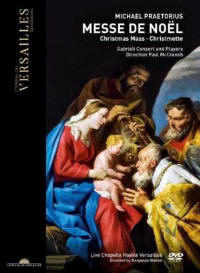Texte paru dans: / Appeared in: |
|
|
Outil de traduction (Très approximatif) |
|
|
Reviewer:
J. F. Weber It is surprising to see this reconstruction of a 1620 Lutheran Mass performed in the royal chapel of Versailles, which was not constructed until over a century later and was dedicated to the celebration of the Catholic Mass. Once the viewer gets over that anomaly, one can revel in the pageantry that Paul McCreesh has been lavishing on similar historical reconstructions, or what the French here call a spectacle. (Yes, a French word, though it is the same as English.) It may have suited the surroundings more at Roskilde Cathedral in Denmark where he recorded exactly the same program (at the same playing time) for Archiv in 1993, just 24 years earlier. Issued as 439 250-2, it was not reviewed in Fanfare, although I covered most of his other such programs, and I don’t remember how a copy came into my collection. Notably, just a year earlier, he had recorded a Christmas Mass centered on Palestrina’s music at Santa Maria Maggiore in Rome. That CD was 437 833-2 (not issued here), but the LaserDisc later appeared as a DVD (Fanfare 31:5). Most of the CDs in my Praetorius collection concentrate on Christmas. David Hill once made a program similar to this in an equally unlikely place, London’s Westminster Cathedral (10:5), but his selection was largely different, for it included only Puer natus in Bethlehem, Quem pastores laudavere, and Wie schön leuchtet der Morgenstern. Franz Raml’s program (20:3) included Puer natus in Bethlehem, this Kyrie and Gloria, and Wie schön leuchtet der Morgenstern. Roland Wilson (21:3) included Puer natus in Bethlehem, Wie schön leuchtet der Morgenstern. and In dulci jubilo. Jeanette Sorrell (31:6) included Quem pastores laudavere and In dulci jubilo. That’s a lot of duplication, but none of them lays out a liturgical service as this DVD does. The term Deutsche Messe here refers only to the Kyrie and Gloria, taken from Polyhymnia caduceatrix et panegyrica (1619). The rest of the service is dominated by seven strophic hymns, as long as 10 stanzas. Beginning with Luther’s Christum wir sollen loben schon (harmonized by Lucas Osiander), the introit is Puer natus in Bethlehem (from the same Polyhymnia), followed by the Kyrie and Gloria, then the collect and epistle (chanted by soloists in the choir, with no attempt to portray liturgical ministers). The gradual is Vom Himmel hoch (from Musae Sioniae of 1607), the nine stanzas distributed among choir boys, soloists, instruments, and congregation, a vivid performance. The chanted gospel is followed by the Credo with Luther’s melody harmonized by Scheidt. Quem pastores laudavere is the pulpit hymn (taken from Puericinium of 1621), one of the more striking selections, each stanza opening with four boys high in the gallery taking one line apiece (one is less secure than the other three). The hour-long sermon that would be heard here is mercifully omitted. In a reversal of the order of the Catholic Mass, the Lord’s Prayer is followed by the words of institution and then the Sanctus (also from Polyhymnia). Next come two communion motets, Wie schön leuchtet der Morgenstern from the same source and Uns ist ein Kindlein heut geboren (from Musae Sioniae of 1609). After the solo post-communion prayer and benediction, the service ends with two hymns, Puer nobis nascitur (from Musae Sioniae of 1609) and a recessional, In dulci jubilo (from the same Polyhymnia), though no one departs. These are both spectacular, but the last most of all, where timpani and a regal are heard for the first time. Interspersed are organ works by Scheidt and Schein. The performers are grouped in the sanctuary, with some trebles, soloists, and an instrumental group placed above in a gallery. Among the players are one on a grand organ, one on a chamber organ, and a lady who takes turns swiveling from a harpsichord to (less often) a virginal. Just once I heard a regal, which may have been in the gallery with the timpani. (The older CD identifies it by name.) The microphones and spotlights are obtrusive but no camera ever comes in sight, although a full panoply of close-ups is used during the live performance. I suspect the close-ups had to have been made separately, though there is no trace of it. One just wonders how they did it. The strophic hymns sometimes seem endless, but this is a rewarding example of McCreesh at his best. It’s good for repeated viewing. J |
|




